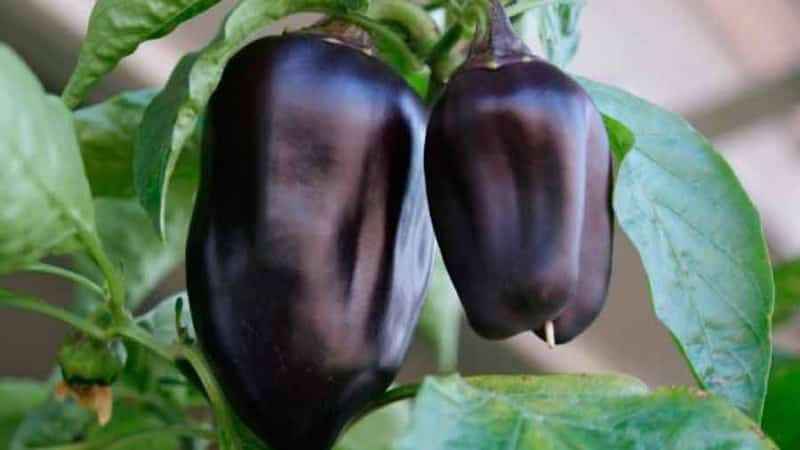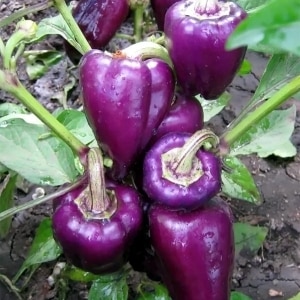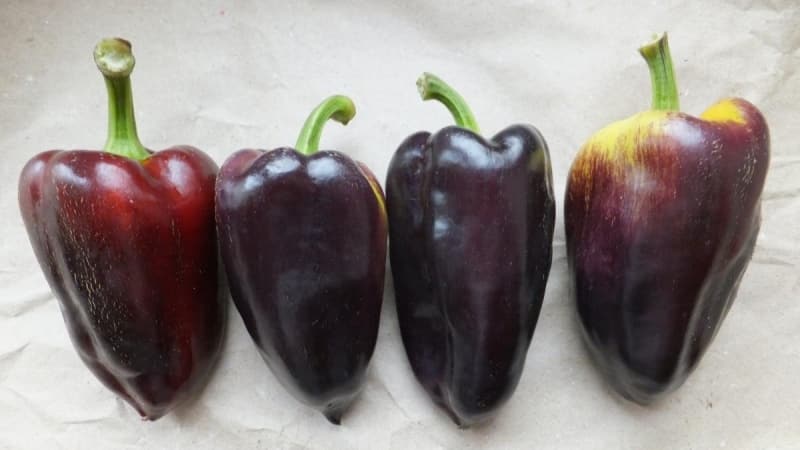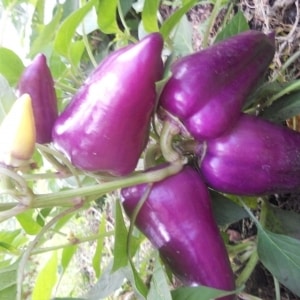The best varieties of purple peppers and their characteristics
Purple peppers attract more and more attention every year: such exotic vegetables decorate any table. Their color depends on the specific variety. Some fruits are colored deep and rich purple, others have a blue tint.
Anthocyanins give peppers their unusual color. What are the benefits of this purple vegetable and what are the most common varieties - read on.
Distinctive features of purple pepper
The high content of anthocyanins not only gives vegetables an unusual color, but also provides high immunity to cold weather.
Many varieties can and should be grown in the North-West region of the country, since anthocyanins absorb solar energy and convert it into heat, thereby increasing their cold resistance. This is the main difference between purple pepper and traditional varieties. Purple, blue and even black pigments appear in peppers when the vegetable is at the stage of technical ripeness.

Unusual fruits affect the human body several times more effectively than yellow or red varieties. Thanks to anthocyanins, regular consumption of purple pepper helps strengthen the walls of blood vessels and lower intraocular pressure. They destroy harmful bacteria in the body and increase overall immunity.
Pepper varieties with purple fruits
There are a great many purple varieties. Gardeners prefer unpretentious and tasty varieties.Let us examine in more detail the most popular types, identifying their distinctive features, advantages and disadvantages.
Amethyst
 An early-ripening variety for open ground ripens within 100-115 days from planting. Summer residents recommend planting it in seedlings, after soaking the seeds. Amethyst is planted in fertile and sunny beds. The variety is unpretentious in care and requires a minimum of time and effort. Productivity is stable, from 1 sq. m farmers annually collect from 10 to 12 kg of tasty and juicy fruits.
An early-ripening variety for open ground ripens within 100-115 days from planting. Summer residents recommend planting it in seedlings, after soaking the seeds. Amethyst is planted in fertile and sunny beds. The variety is unpretentious in care and requires a minimum of time and effort. Productivity is stable, from 1 sq. m farmers annually collect from 10 to 12 kg of tasty and juicy fruits.
The bush grows about 60 cm in height, so it does not require staking or shaping. The weight of one pepper varies from 130 to 160 g. The color is rich red or purple. The walls of the vegetable are dense and fleshy, thanks to which the pepper can be stored for about a month without losing its beneficial properties. Stews and vitamin salads are prepared from the vegetable.
Othello F1
The hybrid matures in 110-120 days. Farmers recommend planting it in a greenhouse or greenhouse. The plant is tall, so over time it requires staking and pinching. The fruits are cone-shaped, deep purple in color. The weight of one pepper is about 110 g, the wall thickness is 6-7 mm. The taste is sweet and juicy, so the vegetable is ideal for preparing pickled and dried dishes for the winter. From 1 sq. m harvest about 9 kg of fruit.
Important! To obtain a rich harvest, peppers are regularly fertilized and fed. Organic fertilizers help improve the quality of fruits and their quantity: liquid manure, chicken droppings, burdock infusion, wood ash. Together with them, mineral complexes and growth stimulants are used, for example, Heteroauxin or Kornevin.
Arab
The early ripening variety ripens in 100-110 days. It is grown outdoors or in greenhouses. The plant is cold-resistant and rarely gets sick.For a good harvest, the beds are watered every 5-7 days. The amount of watering depends on weather conditions.
If the summer is rainy, then water once every 7-10 days. The bushes are compact, about 75 cm high. The peppers have a cone-shaped, elongated shape. The color is rich purple, the taste is soft and juicy. From 1 sq. m harvest 5-6 kg of crop.
Oh yeah
The variety ripens within 115 days from planting. Excellent for regions with unpredictable climatic conditions. The bushes are compact, the height of one is about 50 cm.
The plant does not need special care; the main thing is to regularly water, loosen and fertilize the beds. The fruits are cuboid in shape and dark purple in color. The weight of one fruit is 120-140 g. Pepper can be stored for up to four months in a cool and dark place, for example, the basement of a house. From 1 sq. m harvest about 6 kg of vegetables.
Important! Loosening is a necessary stage of crop care. Due to it, the evaporation of moisture is reduced, the soil retains liquid in itself, and the flow of oxygen to the roots improves, which has a positive effect on the development of fruits. Constant loosening helps to avoid many diseases and unwanted insects in the beds. Carry out the procedure before watering.
Star of the East
The variety is one of the heat-loving and whimsical varieties, so it is best to grow it in central Russia. The fruits ripen in 100-110 days. The shape is cuboid, the weight of one vegetable is about 200 g. Unlike many peppers, the taste of the Eastern Star is neutral.
For the best harvest, summer residents recommend preparing seedlings in March-April. The vegetable is planted in open ground after the spring frosts have passed. The yield is average, about 5-7 kg per 1 sq. m.
This is interesting:
Lilac fog F1
The hybrid is mid-early, ripens in 120-125 days from planting. Recommended for cultivation in northern regions, for example, in the Urals or Siberia. The fruits are small, the weight of one is about 90 g. The color is bright, the flesh is juicy. The plant rarely gets sick and is resistant to insect pests. About 2 kg of exotic and tasty fruits are collected from one bush.
Interesting! Purple peppers make an excellent base for stuffed dishes. Meat, fish, other vegetables, spices and herbs are used as filling. This is an ideal dietary dish that will not harm your figure.
Maxim F1
Small fruits ripen in 120-130 days. Vegetables of red and light purple colors appear on one bush. The length of the pepper reaches about 10 cm, the thickness of the walls is 6-8 mm. The hybrid is cultivated in any climatic conditions, be it sunny Volgograd or harsh Chelyabinsk.
The plant performs well both in greenhouses and in open beds. From 1 sq. m gardeners receive 8 kg of harvest.
Gypsy Baron
A mid-early vegetable shows the first results in 125-135 days. Recommended for cultivation in warm regions. The semi-spreading bush reaches a height of only 60 cm and does not need a garter. The fruits have a cone-shaped shape; red and purple vegetables weighing 120-130 g ripen simultaneously on one plant.
The wall thickness is only 5 mm, so the vegetable is not suitable for long-term storage. From 1 sq. m farmers harvest 3-4 kg of crop.
Lilac Lavender
The literal translation of the name sounds like “lilac masterpiece.” To find and buy seeds of this variety, you need to try very hard. The mid-early vegetable ripens within 110-115 days. It is planted in shifts in open ground.
The bushes are spreading, but reach a height of only 50-60 cm. They do not require special care. The fruits are large, cone-shaped, deep lilac in color. The walls are thick and fleshy, the surface is glossy. The weight of one fruit reaches 400-450 g. Lilac Lavender is excellent for long-term storage and transportation. Universal in use.
Purple Bell
 The mid-season variety is ideal for greenhouses and greenhouses. Planted using seedlings that are previously hardened off. Fleshy fruits at the ripe stage weigh up to 200 g. The color is blue-violet.
The mid-season variety is ideal for greenhouses and greenhouses. Planted using seedlings that are previously hardened off. Fleshy fruits at the ripe stage weigh up to 200 g. The color is blue-violet.
The taste is excellent, the fruits have a sweet, pleasant aroma. The vegetable is actively used in cooking for preparing salads and snacks. Under film covers with 1 sq. m summer residents collect about 8 kg of fruit.
Blot
The mid-early variety is suitable for any region of the country. The bushes are semi-spreading, the height of one is about 60 cm. The pepper is unpretentious in care. The fruits are medium in size, black-violet or dark red in color.
The flesh is crispy, the surface is smooth and even. The weight of one fruit is 130-160 g. The vegetable is perfect for making pickled and dried snacks; peppers look attractive and appetizing in a jar.
Bagheera
The original spherical variety ripens in 125 days. Bagheera is suitable for open beds. Large fruits weigh up to 400 g and are not suitable for long-term storage. The color is dark, the walls are dense. The pulp is pleasant to the taste, there are few seeds.
The variety is resistant to pests and shows stable yields regardless of the growing region. One bush gives summer residents about 2 kg of large and heavy fruits.
Features of growing purple pepper
How to create ideal growing conditions? Before planting, the seeds are soaked in aloe juice or a solution of potassium permanganate. This increases the immunity of future plants and kills dangerous microbes on the surface of the seeds.
To get a rich harvest, experienced gardeners advise adhering to the following rules:
- Store pepper seedlings on a sunny windowsill;
- plant vegetables in the garden on a windless and dry day;
- Before planting, be sure to dig up the beds and add compost or humus to them;
- leave a distance between bushes of at least 40-50 cm, depending on the variety;
- if the fruits are heavy, be sure to tie the bushes to a support;
- water the beds only with settled or rain water;
- remove weeds and weed beds;
- regularly inspect bushes and fruits for the presence of insect pests;
- regularly take preventive measures against diseases.
Important! Purple pepper needs timely feeding. Summer residents advise alternating mineral and organic fertilizers. Two weeks after planting, the plant is fed with ammonium nitrate or superphosphate. Subsequently, every 10-15 days, wood ash and yeast are added to the soil, the bushes are watered with Bordeaux mixture, and 2-3 times a season they are sprayed with whey or nettle infusion, which protect the peppers from aphids, slugs and spider mites.
Reviews
 Judging by the reviews, every year an increasing number of gardeners grow unusual purple varieties on their plots. What bell peppers do Russian summer residents prefer?
Judging by the reviews, every year an increasing number of gardeners grow unusual purple varieties on their plots. What bell peppers do Russian summer residents prefer?
Elena, Orenburg: «I love everything unusual, so every year I try to grow a new vegetable on my plot. Last year it was the Gypsy Baron pepper.I was very pleased with the harvest; the fruits grew evenly, with a beautiful color. I recommend it for cultivation."
Mikhail, Ufa: “I grew Bagheera pepper for two years in a row. I was pleased with the exotic appearance of the vegetable and its pleasant taste. However, the last time the plants fell ill with powdery mildew, which destroyed 60% of the crop. I’m very disappointed, I’ll try other purple varieties next season.”
Irina, Sochi: “I want to praise the Oda and Amethyst varieties. These are my favorites, they always show the best yield. I make preparations from them for the winter, and in the summer I add them to soups and side dishes; there are a great many recipes. The taste of the vegetable is excellent."
Read also:
How to pickle hot peppers for the winter using the best recipes from around the world.
Conclusion
In addition to the traditional yellow and red varieties of peppers, gardeners also grow unusual purple ones. They are not inferior in taste, but bring even more benefits. They are easy to care for and do not differ from hot or chili peppers. They are planted in open ground or in a greenhouse, depending on the growing region.
Most varieties rarely get sick and are not affected by insect pests. Such original vegetables look great on a holiday table or as preparations for the winter.